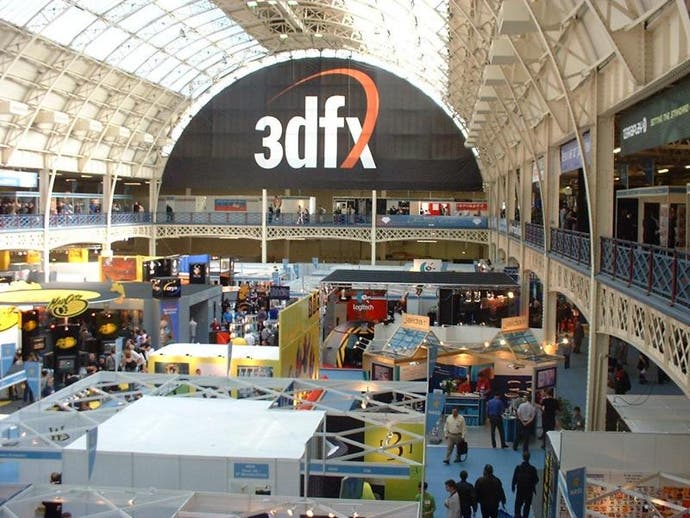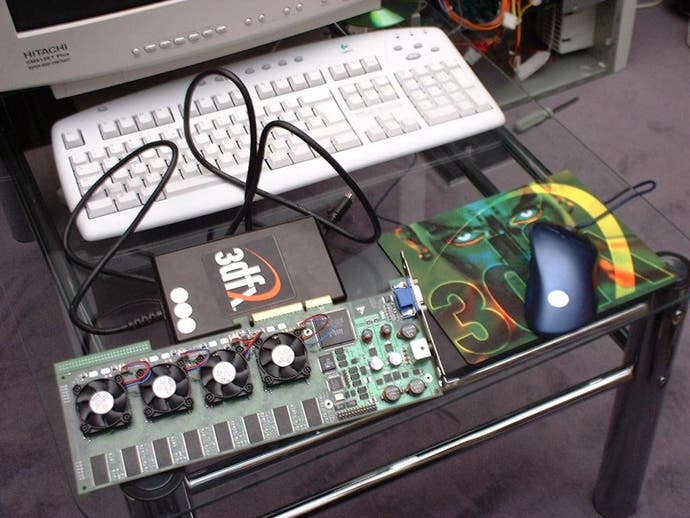Voodoo Child
Article - what does the future hold for NVIDIA and the graphics industry in the wake of 3dfx's collapse?
The gaming community was rocked last Friday when a press release from 3dfx euphemistically entitled "3DFX Announces Three Major Initiatives to Protect Creditors and Maximize Shareholder Value" turned out to be an announcement of the company's demise. Shareholders were less optimistic, and voted with their feet, sending the company's share price into freefall, reaching just 20 cents come Monday morning.
The plan calls for 3dfx's core technologies and brands to be sold to rivals NVIDIA for $70m cash and a million NVIDIA shares (worth just over $30m at the moment), with the management recommending that shareholders vote to dismantle what is left of the company next year. But what does this mean for NVIDIA, and the 3D graphics industry in general? We take a closer look at the deal to find out more...

Technology
One of the key terms of the deal is that NVIDIA will own all seven of 3dfx's patents, plus another forty or more which are still pending, including all of the Gigapixel technologies. Given that 3dfx bought Gigapixel for over $180m just nine months ago, it's clear that NVIDIA are getting a real bargain from this deal. They will also own the work that 3dfx has done so far on its new Rampage and Mosaic products.
According to NVIDIA's CEO Jen-Hsun Huang, the "Gigapixel technology is pretty exciting to us". Although in the end 3dfx came to pieces, NVIDIA believe that their new technology "simply ran out of runway from a financial point of view", and that while "their business strategy might not have been the best, their technology is pretty terrific". What makes the Gigapixel technology so interesting to NVIDIA is tile-based rendering. As 3D games become ever more complex, the number of polygons which are rendered by your graphics card only to be covered up by other objects later in the rendering process increases rapidly. This is known as overdraw, and Gigapixel's technology is intended to reduce this, and hence the amount of data which has to be passed around the memory on the card.
For cards such as the GeForce series, memory bandwidth is now the major limiting factor on real-world performance, and anything that can be done to reduce the strain on what Huang called "our scarcest resource" is obviously going to help matters. The exotic high frequency memory used on the latest GeForce 2 graphics cards is the most expensive single component involved in their manufacture, and it is becoming obvious that the company can't just keep using faster and faster memory to get around the problem.

Patently Absurd
NVIDIA's European marketing director Alan Tiquet told us during the ECTS trade show in London a few months ago that the "next product generation is going to work in different ways to improve the bandwidth using the available memory technologies. We know that there are limits, and we are going to go to those limits, and then we have to find different ways [around them]. This is what we are dealing with today".
Owning the rights to the Gigapixel technology may help them in this to some extent, but on closer inspection it isn't quite as straightforward as it may sound. Huang told investors that NVIDIA are "going to quickly take a look at [3dfx's technologies] .. and assess how much of them to incorporate" into their own future products. But we can be fairly certain that we won't see any fruits from this for at least another year, as NVIDIA already have their new NV20 chip aiming for a spring 2001 launch, with a faster version of the card almost sure to follow in the autumn. In fact, any benefits from the influx of 3dfx technology and engineers are most likely to be seen in the third design team at NVIDIA, who are working on a product for launch in spring 2002, which is still early in development and maybe sixteen months from release.
In fact the real key here is perhaps the patents themselves, rather than the technologies that they describe. NVIDIA was involved in two expensive patent infringement cases with 3dfx, with each side launching claims and counter-claims against each other. If NVIDIA had lost the case that 3dfx had brought against them, they could have found themselves $100m out of pocket, and so buying the patents from 3dfx was actually a cost-effective option. It also means that NVIDIA no longer have to waste time and resources on fighting the cases in court, allowing them to concentrate on vital research and growing their business. It's even possible that some of the patents they now own may allow them to launch new cases against ATI in future, crippling their last remaining rival in the 3D consumer graphics market, who are themselves facing financial difficulties as NVIDIA cut into their once dominant position in the laptop, Macintosh and OEM markets.

Branded
It's not just about technology and patents though. Another of the main terms of the 3dfx deal sees their Voodoo brand name transferring to NVIDIA, and CEO Jen-Hsun Huang pointed out that 3dfx "have invested millions in the Voodoo brand; it's a well recognised brand, and in the gamer community it is still the brand of choice", representing anything up to 40% of the retail market.
"By combining the best technology from NVIDIA and the Voodoo brand from 3dfx we have some pretty terrific opportunities in the retail channel", enthused Huang, who added that "we plan to do something that we're quite excited about". In one of life's great ironies, we could be about to see NVIDIA's products being rebranded with the name which their biggest rivals spent the last five years promoting. "At the highest level the brand will continue to be NVIDIA. Where we can really take advantage of the 3dfx brand is .. the retail and gaming markets".
Huang told investors that "combined with our GeForce technology, we'll have an opportunity to grow our retail market share from about 30% to something well north of 60 or 70%". With only ATI left to compete with them, NVIDIA look likely to totally dominate the fluctuating retail add-in market in coming years, assuming they can continue to deliver products in a timely fashion. They already have arguably the best product at every price point from entry level (GeForce MX) to high-end enthusiast (GeForce 2 Ultra), and with the exit of 3dfx from the market they will be in a commanding position.

Laurels
The big question then is whether having only one or two major players in the market will harm the graphics and gaming industries. On the one hand it means that there is less choice for consumers, and less competition to keep NVIDIA pushing at the cutting edge of technology. On the other hand it means further concentration of the industry's top engineers at the company, and access to even greater resources to cover future research and investment.
One of the most important effects of the continuing consolidation in the 3D graphics industry is that game developers will have a more uniform platform at which to aim their products, which has been one of the big advantages of console game development in the past. After all, apart from the fill rate, the basic features of the entire GeForce range from the MX to the Ultra are essentially the same. With NVIDIA continuing to work closely with Microsoft, their cards are likely to offer excellent support for future versions of DirectX, which in turn is increasingly supporting the features which top game developers are demanding.
As long as NVIDIA don't rest on their laurels in the way that 3dfx did following the release of their Voodoo 2, this could actually prove to be a good thing for gamers. Until now the consumer graphics card industry has been fragmented, with a whole range of different feature sets and APIs for game developers to choose between. With only two major players left in the high end 3D gaming market, ATI and NVIDIA, and both of them pledging support for DirectX, this problem is largely solved.

Conclusion
This deal was really something of a no-brainer for NVIDIA. It saves them from the time, expense and distraction of the court cases they were tied up in, it removes one of their oldest rivals from the market, it gains them some great new technology which is going to be key to the future development of the 3D graphics industry at a knock-down price, and it gives them access to the still popular Voodoo brand name. They have also taken advantage of 3dfx's collapse to offer around a hundred former 3dfx engineers jobs at NVIDIA, bringing in a new influx of talented and experienced software and hardware developers to work on future products.
The real benefits of this deal aren't going to be seen until 2002, with the likely release of the first NVIDIA products to include 3dfx technology and expertise, but even before then we may see NVIDIA taking advantage of the Voodoo brand name to increase their already impressive retail market share. The only real risk for gamers is that NVIDIA and the board manufacturers who buy their chips will also take advantage of the reduction in competition to improve their margins, increasing the already exhorbitant price of cutting edge hardware such as the GeForce 2 Ultra.
However, if there is one thing that the last few years have shown, it is that the graphics card industry is full of surprises, and even the technological and market leaders can't afford to let their guard down. The arrival of 3dfx marked the end of S3, Matrox and other companies who failed to keep up with the 3D revolution, while NVIDIA soon rose to the top as soon as 3dfx started to fall behind the curve. While the costs of entering this industry continue to rise, there will always be somebody waiting in the wings to pick up the flame if NVIDIA should stumble...
-
Alan Tiquet (NVIDIA) interview

